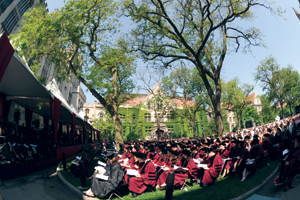Graduated circumstances
The University moves to a joint convocation ceremony on the main quad.
By Amy Braverman Puma
Photography by Dan Dry
I didn’t attend my college graduation ceremony, opting instead to take part in a journalism competition in San Francisco the same weekend. My mother, who knows all the words to “Pomp and Circumstance” (she learned the “Land of Hope and Glory” lyrics as a child), was not pleased. So when I—and she—got another chance for my master’s degree, we took it.

Harper quad has served as grounds for its last spring convocation ceremony.
In a Big Ten football stadium north of Hyde Park, we graduates took our seats. Secretary of State Madeleine Albright had been scheduled to speak, but she had more important things to do that day, regarding Kosovo. The substitute did a fine job, I vaguely recall (Google reminds me it was then–Morehouse College President Walter E. Massey, former Chicago physics professor, vice president for research, and Argonne director). It was sunny, and I posed for photos with family and friends. That’s all I remember of the big ceremony. I don’t even recall if my mom got to sing along to her song.
The smaller ceremony for the journalism school, however, left a more lasting impression. As the graduates entered, a jazz band played “When the Saints Go Marching In”—a different feel from “Pomp.” The dean spoke, and my mind didn’t trail off as it did at the football stadium. I knew the people sitting near me and could see my family.
I thought about both ceremonies when I learned that Chicago plans to raise the grandeur of its spring convocations, starting next June. Rather than Harper quad, which seats 7,000, the event will take place on the main quad, with seating for 20,000–25,000 people. The College, divisions, and schools all will participate in the same ceremony, “returning us to our tradition,” says Vice President and Secretary of the University David Fithian, of uniting the entire Chicago community, as William Rainey Harper proclaimed should be done at the first convocation—a term he chose instead of commencement specifically for that reason. At the 1893 event, Harper said one purpose of the ceremony was “to bind together into a unity the many complex and diverging forms of activity which constitute our university life and work....”
Having one large ceremony has other benefits, says Fithian, whose office oversees convocations. The speaker will only have to give his or her address once. Families and friends won’t need tickets, allowing graduates to invite as many guests as they’d like. And all degree candidates will get to observe honorary degrees and teaching prizes. Some traditions will remain. College graduates will still process through Hull Gate, while their fellow graduates will enter from the west and the south. The bagpipers will lead the march. A faculty member will give the address.
Of course, with so many graduates at the morning event, their names won’t get called, and degrees and hoods won’t be conferred. That important role now shifts to the smaller afternoon ceremonies for each division and school. The deans will address the students and hand out degrees in a more intimate setting (the College will return to the main quad). And both events, one hopes, will be memorable.
Then again, what do I know? My degrees are in print journalism (see “Read All About It [Somewere]”).—A.B.P.
